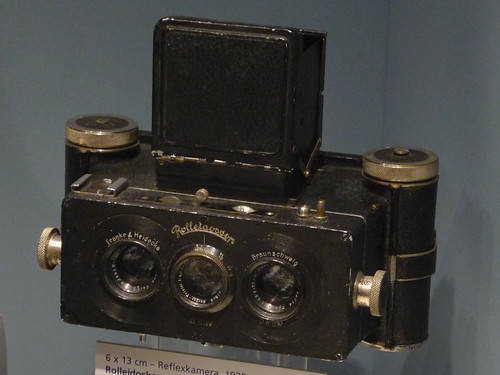Rolleidoscop

|
| Rolleidoscop (1926) Deutsches Technikmuseum Berlin image by Danipuntocom (Image rights) |
The Rolleidoscop is a stereo camera with a reflex viewfinder, made by Franke and Heidecke (later Rollei-Werke Franke & Heidecke). It is very similar to the Heidoscop, of which it is a development, but is built only for roll film, while the Heidoscop was made for plates or film packs, and can take a roll film back.
The first model of the Rolleidoscop, made from 1926-40, is a roll-film version of the Heidoscop for 6×13 cm plates; it makes stereo pairs of 6×6 cm images; four pairs on 120 size roll film. The following year (1927-32) a smaller version was made, for five 4×4 cm stereo pairs on 127 film.[1] This model is less commmon. Film advance is by use of a red window; the back of the camera is marked as to what frame numbers are used for each stereo pair.
Most of the camera's features are the same as the Heidoscop:
- The taking lenses are f/4.5 Tessars (7.5 cm focal length on the 120-film model, and 5.5 cm on the 127 film camera), and the viewing lens is a Zeiss triplet.
- The shutter is a stereo Compound, with speeds 1 to 1/300 second, plus 'B' and 'T' ('M' and 'Z').
- The viewfinder hood has a focusing loupe, and a mirror that allows it to be used as an eye-level reflex finder.
- The camera has a rising front; the front section of the body simply slides upwards.
- Some versions of the camera have a hinged lens cap that covers the taking and viewing lenses (and doubles as a sun-shade); on others, the cap is attached to the camera on a cord. It was also supplied with a single lens cap, allowing it to be used for non-stereo photography simply by capping one of the taking lenses.
Notes
Links
- 6×6 cm Rolleidoscop in an auction in January 2007 by Christie's in London.
- 6×6 cm Rolleidoscop in an auction in September 2006 by Auction Team Breker in Cologne.
- Instructions for Rolleidoscop at Robert R. Thurston's Stereo Images from Juneau site.
- Heidoscop/Rolleidoscop brochure at Butkus.org